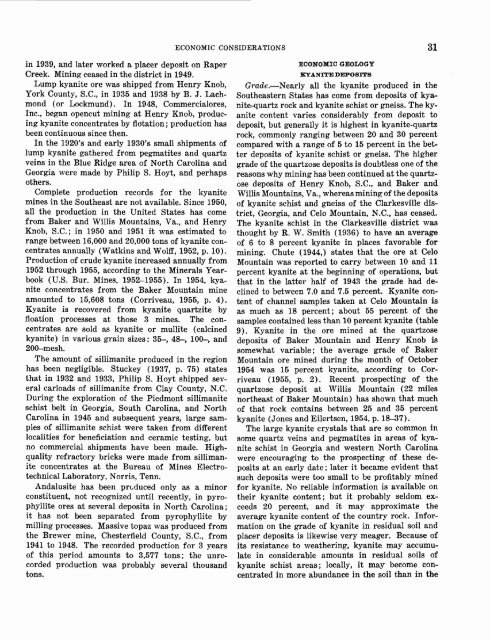Kyanite, Sillimanite, and Andalusite Deposits of the Southeastern ...
Kyanite, Sillimanite, and Andalusite Deposits of the Southeastern ...
Kyanite, Sillimanite, and Andalusite Deposits of the Southeastern ...
You also want an ePaper? Increase the reach of your titles
YUMPU automatically turns print PDFs into web optimized ePapers that Google loves.
ECONOMIC CONSIDERATIONS 31<br />
in 1939, <strong>and</strong> later worked a placer deposit on Raper<br />
Creek. Mining ceased in <strong>the</strong> district in 1949.<br />
Lump kyanite ore was shipped from Henry Knob,<br />
York County, S.C., in 1935 <strong>and</strong> 1938 by B. J. Lachmond<br />
(or Lockmund). In 1948, Commercialores,<br />
Inc., began opencut mining- at Henry Knob, producing<br />
kyanite concentrates by flotation; production has<br />
been continuous since <strong>the</strong>n.<br />
In <strong>the</strong> 1920's <strong>and</strong> early 1930's small shipments <strong>of</strong><br />
lump kyanite ga<strong>the</strong>red from pegmatites <strong>and</strong> quartz<br />
veins in <strong>the</strong> Blue Ridge area <strong>of</strong> North Carolina <strong>and</strong><br />
Georgia were made by Philip S. Hoyt, <strong>and</strong> perhaps<br />
o<strong>the</strong>rs.<br />
Complete production records for <strong>the</strong> kyanite<br />
mines in <strong>the</strong> Sou<strong>the</strong>ast are not available. Since 1950,<br />
all <strong>the</strong> production in <strong>the</strong> United States has come<br />
from Baker <strong>and</strong> Willis Mountains, Va., <strong>and</strong> Henry<br />
Knob, S.C.; in 1950 <strong>and</strong> 1951 it was estimated to<br />
range between 16,000 <strong>and</strong> 20,000 tons <strong>of</strong> kyanite concentrates<br />
annually (Watkins <strong>and</strong> Wolff, 1952, p. 10).<br />
Production <strong>of</strong> crude kyanite increased annually from<br />
1952 through 1955, according to <strong>the</strong> Minerals Yearbook<br />
(U.S. Bur. Mines, 1952-1955). In 1954, kyanite<br />
concentrates from <strong>the</strong> Baker Mountain mine<br />
amounted to 15,608 tons (Corriveau, 1955, p. 4).<br />
<strong>Kyanite</strong> is recovered from kyanite quartzite by<br />
floation processes at those 3 mines. The concentrates<br />
are sold as kyanite or mullite (calcined<br />
kyanite) in various grain sizes: 35-, 48-, 100-, <strong>and</strong><br />
200-mesh.<br />
The amount <strong>of</strong> sillimanite produced in <strong>the</strong> region<br />
has been negligible. Stuckey (1937, p. 75) states<br />
that in 1932 <strong>and</strong> 1933, Philip S. Hoyt shipped several<br />
carloads <strong>of</strong> sillimanite from Clay County, N.C.<br />
During <strong>the</strong> exploration <strong>of</strong> <strong>the</strong> Piedmont sillimanite<br />
schist belt in Georgia, South Carolina, <strong>and</strong> North<br />
Carolina in 1945 <strong>and</strong> subsequent years, large samples<br />
<strong>of</strong> sillimanite schist were taken from different<br />
localities for beneficiation <strong>and</strong> ceramic testing, but<br />
no commercial shipments have been made. Highquality<br />
refractory bricks were made from sillimanite<br />
concentrates at <strong>the</strong> Bureau <strong>of</strong> Mines Electrotechnical<br />
Laboratory, Norris, Tenn.<br />
<strong>Andalusite</strong> has been produced only as a minor<br />
constituent, not recognized until recently, in pyrophyllite<br />
ores at several deposits in North Carolina;<br />
it has not been separated from pyrophyllite by<br />
milling processes. Massive topaz was produced from<br />
<strong>the</strong> Brewer mine, Chesterfield County, S.C., from<br />
1941 to 1948. The recorded production for 3 years<br />
<strong>of</strong> this period amounts to 3,577 tons; <strong>the</strong> unrecorded<br />
production was probably several thous<strong>and</strong><br />
tons.<br />
ECONOMIC GEOLOGY<br />
KYANITE DEPOSITS<br />
Grade. Nearly all <strong>the</strong> kyanite produced in <strong>the</strong><br />
Sou<strong>the</strong>astern States has come from deposits <strong>of</strong> kyanite-quartz<br />
rock <strong>and</strong> kyanite schist or gneiss. The kyanite<br />
content varies considerably from deposit to<br />
deposit, but generally it is highest in kyanite-quartz<br />
rock, commonly ranging between 20 <strong>and</strong> 30 percent<br />
compared with a range <strong>of</strong> 5 to 15 percent in <strong>the</strong> better<br />
deposits <strong>of</strong> kyanite schist or gneiss. The higher<br />
grade <strong>of</strong> <strong>the</strong> quartzose deposits is doubtless one <strong>of</strong> <strong>the</strong><br />
reasons why mining has been continued at <strong>the</strong> quartzose<br />
deposits <strong>of</strong> Henry Knob, S.C., <strong>and</strong> Baker <strong>and</strong><br />
Willis Mountains, Va., whereas mining <strong>of</strong> <strong>the</strong> deposits<br />
<strong>of</strong> kyanite schist <strong>and</strong> gneiss <strong>of</strong> <strong>the</strong> Clarkesville district,<br />
Georgia, <strong>and</strong> Celo Mountain, N.C., has ceased.<br />
The kyanite schist in <strong>the</strong> Clarkesville district was<br />
thought by R. W. Smith (1936) to have an average<br />
<strong>of</strong> 6 to 8 percent kyanite in places favorable for<br />
mining. Chute (1944,) states that <strong>the</strong> ore at Celo<br />
Mountain was reported to carry between 10 <strong>and</strong> 11<br />
percent kyanite at <strong>the</strong> beginning <strong>of</strong> operations, but<br />
that in <strong>the</strong> latter half <strong>of</strong> 1943 <strong>the</strong> grade had declined<br />
to between 7.0 <strong>and</strong> 7.5 percent. <strong>Kyanite</strong> content<br />
<strong>of</strong> channel samples taken at Celo Mountain is<br />
as much as 18 percent; about 55 percent <strong>of</strong> <strong>the</strong><br />
samples contained less than 10 percent kyanite (table<br />
9). <strong>Kyanite</strong> in <strong>the</strong> ore mined at <strong>the</strong> quartzose<br />
deposits <strong>of</strong> Baker Mountain <strong>and</strong> Henry Knob is<br />
somewhat variable; <strong>the</strong> average grade <strong>of</strong> Baker<br />
Mountain ore mined during <strong>the</strong> month <strong>of</strong> October<br />
1954 was 15 percent kyanite, according to Corriveau<br />
(1955, p. 2). Recent prospecting <strong>of</strong> <strong>the</strong><br />
quartzose deposit at Willis Mountain (22 miles<br />
nor<strong>the</strong>ast <strong>of</strong> Baker Mountain) has shown that much<br />
<strong>of</strong> that rock contains between 25 <strong>and</strong> 35 percent<br />
kyanite (Jones <strong>and</strong> Eilertsen, 1954, p. 18-37).<br />
The large kyanite crystals that are so common in<br />
some quartz veins <strong>and</strong> pegmatites in areas <strong>of</strong> kyanite<br />
schist in Georgia <strong>and</strong> western North Carolina<br />
were encouraging to <strong>the</strong> prospecting <strong>of</strong> <strong>the</strong>se deposits<br />
at an early date; later it became evident that<br />
such deposits were too small to be pr<strong>of</strong>itably mined<br />
for kyanite. No reliable information is available on<br />
<strong>the</strong>ir kyanite content; but it probably seldom exceeds<br />
20 percent, <strong>and</strong> it may approximate <strong>the</strong><br />
average kyanite content <strong>of</strong> <strong>the</strong> country rock. Information<br />
on <strong>the</strong> grade <strong>of</strong> kyanite in residual soil <strong>and</strong><br />
placer deposits is likewise very meager. Because <strong>of</strong><br />
its resistance to wea<strong>the</strong>ring, kyanite may accumulate<br />
in considerable amounts in residual soils <strong>of</strong><br />
kyanite schist areas; locally, it may become concentrated<br />
in more abundance in <strong>the</strong> soil than in <strong>the</strong>
















